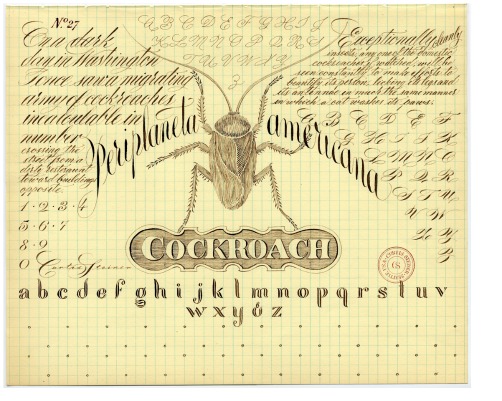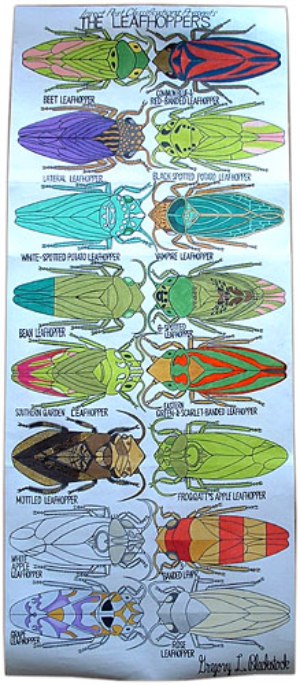In the 11 years he has operated his aesthete’s paradise/curio and jewelry shop in Ballard, called Souvenir, Curtis Steiner has never featured himself in a solo show, till now, through Dec. 3. The insects in his ink drawings on paper – Insects and Alphabets
– step on dainty feet out of 19th Century England, when entomology was a
pastime as common as chess, surrounded by the kind of elegant handwriting that helped define the leisure
class.
 Each
Each
insect holds court on the page, antenna twitching, surrounded by the
calligraphy known as cursive. Last year, when my nephew Rafferty was
five, he showed me a sample of his, calling it “curse writing.”
(“Cursive,” I told him. “No,” he said with a scowl, “curse
writing.”)
Rafferty is a fan of Steiner’s, thanks to Steiner’s interactive project at the Seattle Art Museum titled, 1,000 Blocks.(Steiner’s manipulations here.) Steiner’s arrangements are top hat and tail; Rafferty’s are dockworker, blocks roughing each other up in muscled heaps.
Steiner’s
interest in lists of things is not so nearly extinct as his fine hand.
The urge to categorize and define animates the work of his polar
opposite, Gregory Blackstock, who from memory draws images he has seen in dictionaries, encyclopedias
and other source books, starting with outlines and shading in. Each of
his drawings is a list, and the paper is often cut and taped together
into a kind of scroll, punctuated by block writing.
 We
We
inhabit the world by naming its parts. In times of upheaval, names blur
and opposites stand in for each other, perfectly illustrated in 1942 by
Henry Reed, whose mind in the middle of World War II productively wandered between sex
and death.
NAMING OF PARTS
To-day we have naming of parts. Yesterday,
We had daily cleaning. And to-morrow morning,
We shall have what to do after firing. But to-day,
To-day we have naming of parts. Japonica
Glistens like coral in all of the neighboring gardens,
And to-day we have naming of parts.This is the lower sling swivel. And this
Is the upper sling swivel, whose use you will see,
When you are given your slings. And this is the piling swivel,
Which in your case you have not got. The branches
Hold in the gardens their silent, eloquent gestures,
Which in our case we have not got.This is the safety-catch, which is always released
With an easy flick of the thumb. And please do not let me
See anyone using his finger. You can do it quite easy
If you have any strength in your thumb. The blossoms
Are fragile and motionless, never letting anyone see
Any of them using their finger.And this you can see is the bolt. The purpose of this
Is to open the breech, as you see. We can slide it
Rapidly backwards and forwards: we call this
Easing the spring. And rapidly backwards and forwards
The early bees are assaulting and fumbling the flowers:
They call it easing the Spring.They call it easing the Spring: it is perfectly easy
If you have any strength in your thumb: like the bolt,
And the breech, and the cocking-piece, and the point of balance,
Which in our case we have not got; and the almond-blossom
Silent in all of the gardens and the bees going backwards and forwards,
For to-day we have naming of parts.



Hello, Regina! Fascinating piece. Where can one see more of Steiner’s Insects and Alphabets? Good wishes, Tobi Tobias
Hi Tobi. There is no way, aside from seeing them first hand at Steiner’s shop. You could if you don’t live in Seattle, ask him to send you images. Send me an email (anotherbb(at)gmail.com and I’ll respond with his. Regina
Regina,
Take a look at Marc Dennis ‘bug’ paintings. He eats them too (earlier this month on the Cooking chanel).
gg
good to read you again..
I wish I hadn’t missed that!